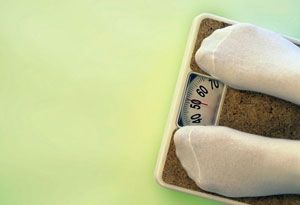3 Steps to Weight Loss Success

Photo: Thinkstock
Are you carrying extra weight that could make you seriously ill? Do you have only "those last five pounds" to go, but they're driving you crazy? Are you already working out, but it's not exactly working? Pamela Peeke, MD, assistant clinical professor of medicine at the University of Maryland School of Medicine, Lluminari member and Pew scholar in nutrition and metabolism, has developed a three-step assessment to help you get your bearings.
Step 1: Is your weight healthy for you? Body mass index (BMI)—a measure of how heavy you are relative to your height—is an indicator of whether your weight is healthy or whether it puts you at risk for serious problems like adult-onset diabetes and heart disease. To determine your BMI, take your weight and divide it by your height in inches. Divide it again by your height in inches, then multiply by 703. Example: If you weigh 150 pounds and are five feet six inches, your BMI would be 150 divided by 66, divided by 66, times 703, which equals 24.2. If the math is painful, you can find instant calculators online (try NHLBISupport.com/bmi/).
In an ideal world: The National Institutes of Health guidelines recommend that most women have a BMI of 18.5 to 24.9.
Let's get real: "I would love your BMI to be anything that starts with two," says Peeke, also the author of Fight Fat After Forty. "I don't care if it's 29.999. It's when the BMI hits 30 that you're starting to run into morbidity and mortality. Unless the woman is an athlete, I'd also worry if it was below 17."
Step 2: What are you made of?
Find out what your body fat percentage is. If you work out at a gym, ask a certified trainer to take a skin caliper measurement. Or you can get your doctor to give a more accurate assessment with a bioelectrical impedance analysis (BIA), which uses a small electrical signal to detect fat. Make sure you're not dehydrated, or your body fat will be overestimated.
In an ideal world: Your percentage would be 25 percent or below, says Peeke, especially if you're in your 20s or 30s. As you get older, your body fat percentage naturally goes up, so the less you start out with, the better off you'll be.
Let's get real: If you're in your 30s, aim for 27 percent; if you're over 40 and your body fat percentage is in the 30s, try to get it down to 31. Anyone with 40 percent body fat or above is in the danger zone—losing weight could save your life.
Step 3: Location, location, location
People who naturally put on weight around the middle are known to have higher risks of heart disease and diabetes than those who gain on the hips and thighs. You've got an extra risk if you're accumulating fat deep inside the abdomen, which, according to Peeke, is caused in part by chronic stress. To find out how you shape up, measure the smallest part of your waist, then the widest part of your hip/butt. Divide the waist by the hip. This is your waist-to-hip ratio. Next, lie on your back and poke your belly until you find the muscular wall: Try to feel whether it lies flat or bulges.
In an ideal world: Your waist-to-hip ratio is 0.7 or lower, and your abdominal wall lies flat.
Let's get real: A ratio of 0.8 means you should pay attention; 0.85 or above means you're at higher risk and losing weight is a health issue. If your stomach wall makes a raised arc, indicating inner abdominal fat, you should also focus on increasing your stress resilience this year.
The Clothes-O-Meter
For a no-tech tool that you can use throughout the year to keep tabs on how you're shaping up, try what Peeke calls the clothes-o-meter. Find an old pair of jeans or pants that you can barely fit into: the fly doesn't zip, the waist won't button—"something you can definitely put on but that isn't suitable for public consumption," she says. Every month pull those pants on. "At first you can only get the fly halfway up," Peeke says. "The next month, maybe three-quarters. Finally, you get it all the way up, but breathing's optional. You'll know you've made real progress when you can jump into those pants and sit down and eat in them."
One last thought
Take a moment to observe a woman you know from another racial or ethnic background, and search for what's beautiful about her, "not just how nice her skin or hair is," says Byllye Avery, founder of the National Black Women's Health Project and the author of An Altar of Words: Wisdom, Comfort, and Inspiration. "It might be the way she is with her children, the little twist she puts on a scarf, the way she moves. If you know only one picture of beauty, then you're saying there's something wrong with the other 95 percent of people, and it can't be healthy to look at the world that way. Part of claiming who you are is being able to accept all the varieties of beauty."
More Diet Advice:



